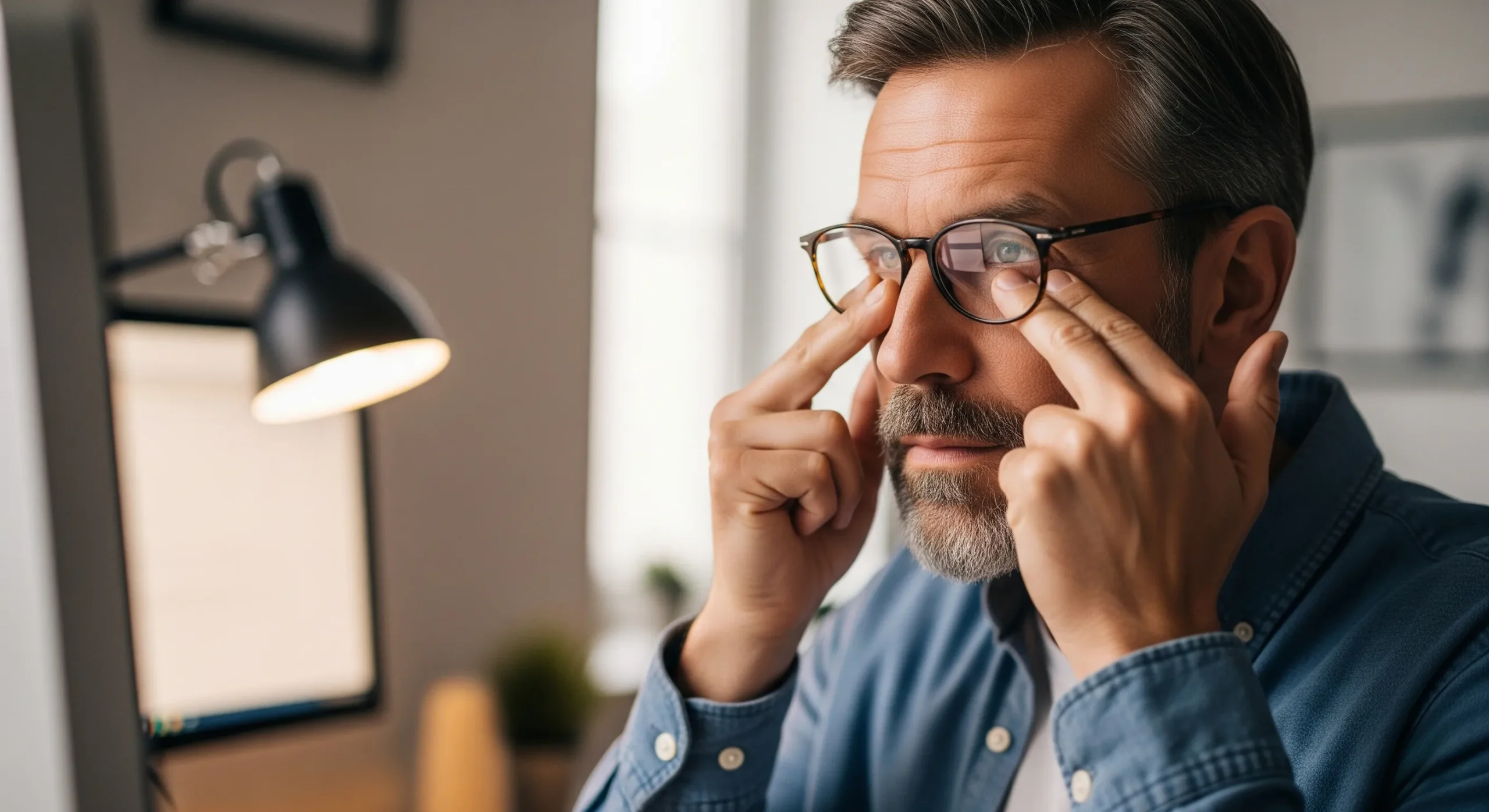How to Reduce Eye Strain Naturally from Screen Time

We live in a world that dances on the rhythm of screens. Phones, laptops, TVs, tablets — they’re everywhere. From sunrise to bedtime, many of us are glued to our screens, chasing emails, attending meetings, streaming shows, or doom-scrolling through social media. But let’s be real — our eyes are paying the price. If you’ve felt that dry, burning, tired sensation in your eyes after a long day of work, you’re not alone. It’s called eye strain, and it’s become a modern-day nuisance that sneaks up on all of us.
The good news? You don’t need fancy gadgets or eye drops to fix it. There are natural, simple, everyday habits that can ease the discomfort. In this article, I’ll walk you through my personal journey and research-backed tips on how to reduce eye strain naturally from screen time — in ways that feel doable and comforting. Trust me, your eyes will thank you.
Understanding Eye Strain: The Silent Burn Behind the Screen
I didn’t always notice the strain. It started subtly. A bit of squinting here, a tension headache there. But over time, I realized my eyes were telling me they were tired — just like how your muscles feel sore after a workout. This condition is often called digital eye strain or computer vision syndrome. And it’s incredibly common.
When we stare at screens, we blink less — sometimes up to 60% less. Blinking helps keep our eyes moist and refreshed. Without it, dryness creeps in. The blue light from screens also messes with our focus, forcing our eyes to work overtime. It’s like making your eyes run a marathon they didn’t sign up for.
According to the American Optometric Association, symptoms of digital eye strain include:
-
Blurry vision
-
Dry or watery eyes
-
Headaches
-
Neck and shoulder pain
-
Difficulty focusing
And here’s the kicker: even children now report these symptoms. The rise of e-learning and mobile games means this issue isn’t just for office workers anymore — it’s a family affair. That’s why it’s more important than ever to find natural ways to reduce eye strain and give our eyes the rest they deserve.
The 20-20-20 Rule: A Tiny Habit That Makes a Big Difference
If there’s one tip you remember from this article, make it this one: the 20-20-20 rule. This gem changed everything for me.
Here’s how it works:
Every 20 minutes, look at something 20 feet away for 20 seconds.
Simple, right? But let me tell you — this tiny habit has huge impact. When I first started doing it, I had to set reminders on my phone. But soon, it became second nature. Just glancing out the window or looking across the room gave my eyes a mini vacation. And like a breath of fresh air, it helped them reset.
Why does this work? Because staring at a screen locks our eyes into a fixed focus. That causes the muscles around our eyes to get stiff and tired. Looking into the distance helps them relax — like stretching after sitting too long.
You can even turn it into a fun ritual. Stand up, sip some water, do a quick stretch. Your whole body gets to reset, not just your eyes.
Blink More: Moisture is Magic
Do you remember the last time you blinked? Sounds silly, but I bet you just blinked reading that. That’s good — because blinking is like a spa treatment for your eyes.
When we use screens, our blink rate drops significantly. Normally, we blink around 15-20 times per minute. But during screen time? That number can fall to as low as 5. No wonder our eyes get dry and irritated.
I started consciously blinking more, especially when I felt the dryness creeping in. At first, it felt weird — like forcing a smile in a mirror. But over time, I trained myself to blink fully and regularly. It became a soothing, almost meditative habit.
You can also try palming — a simple technique where you rub your hands together to warm them, then gently cup them over your closed eyes. Just sit like that for 30 seconds. It’s surprisingly calming and brings instant relief to tired eyes.
Natural Light and Screen Settings: Creating an Eye-Friendly Zone
Lighting can make or break your screen experience. One thing I learned the hard way was how harsh artificial lighting can mess with your focus and stress your eyes. Fluorescent lights, glare from windows, and even too-dark rooms — all of them can contribute to discomfort.
I started making small changes:
-
Letting in more natural light during the day
-
Using soft, indirect lamps instead of overhead lights
-
Adjusting my screen brightness to match the room
-
Turning on blue light filters on all my devices
These tweaks transformed my workspace into a cozier, eye-friendly zone. I even added a few plants near my desk. Not only do they brighten the space, but the green color is easy on the eyes and calming to look at.
Here’s a quick comparison table:
| Adjustment | Eye Strain Impact | Personal Tip |
|---|---|---|
| Natural Light | Reduces glare | Work near a window if you can |
| Screen Brightness | Matches ambient light | Keep it slightly dimmer at night |
| Blue Light Filter | Minimizes strain & glare | Use apps like f.lux or built-in night modes |
| Room Lighting | Reduces sharp contrast | Use soft white LED lamps |
Try these for a few days. You’ll notice the difference.
Stay Hydrated and Eat Eye-Friendly Foods
Your eyes aren’t just affected by what you do — they’re influenced by what you consume, too. One major mistake I made was ignoring hydration. I used to chug coffee all day and wonder why my eyes felt dry. Turns out, dehydration can worsen eye strain significantly.
Now, I keep a bottle of water at my desk and make a habit of sipping it regularly. Staying hydrated helps keep the tear film on your eyes stable, which means less dryness and irritation.
I also added more eye-healthy foods to my diet. These are rich in nutrients like omega-3 fatty acids, vitamin A, vitamin C, and zinc — all vital for eye function. Here are some good ones:
-
Carrots (of course!)
-
Spinach and kale
-
Salmon and other fatty fish
-
Oranges and citrus fruits
-
Eggs
-
Almonds
A handful of almonds or a smoothie with spinach and berries makes a great eye-loving snack. It’s not a magic cure, but it supports your eyes from the inside out.
Give Your Eyes the Gift of Breaks
Our eyes aren’t machines. They need downtime. But many of us — myself included — push through long hours without stepping away from the screen. Over time, I started feeling the fatigue in my eyes the same way you feel it in your back after sitting too long.
That’s when I began scheduling intentional breaks. Not just for my eyes, but for my whole body. Every hour or so, I’d get up, stretch, step outside, or just walk around the house. Even two minutes away from the screen made a difference.
Here are some ideas for screen-free breaks:
-
Take a walk
-
Listen to music with your eyes closed
-
Water your plants
-
Do a quick breathing exercise
-
Doodle or journal on paper
The goal is to engage your senses in a way that doesn’t involve looking at a screen. It’s a gift your eyes — and your nervous system — will truly appreciate.
Screen Hygiene: Small Habits, Big Relief
Good habits around screen use can prevent eye strain before it starts. I call it screen hygiene, and it’s as important as brushing your teeth. It’s about setting boundaries and being mindful.
Here’s what helped me:
-
Position your screen so it’s about 20-30 inches from your eyes and slightly below eye level
-
Clean your screen regularly to avoid squinting at smudges
-
Increase text size so you’re not leaning in to read
-
Use dark mode at night or in dim rooms
Small actions, big relief. Once you get into the rhythm of these habits, they become part of your flow — and your eyes will feel the difference.
The Emotional Toll: Don’t Ignore the Mental Connection
Let’s talk about something often overlooked — the emotional side of eye strain. When my eyes feel tired or blurry, I notice a drop in my mood. I get irritable. I can’t focus. It makes everything feel harder than it should be.
That’s because our eyes aren’t just seeing tools — they’re part of how we experience the world. When they’re overworked, our mental clarity suffers, too.
So, part of caring for your eyes naturally includes managing stress. For me, that meant adding short mindfulness sessions to my day — just five minutes of deep breathing, sometimes with my eyes closed, to reset.
Emotional self-care equals eye care, too.
Final Thoughts: Your Eyes Deserve Gentle Care
Taking care of your eyes doesn’t need to be complicated. In fact, it should feel nurturing, like giving yourself a warm cup of tea or a cozy nap. You don’t need expensive tools — just a few mindful habits, some patience, and a little love.
To recap, here are natural ways to reduce eye strain from screen time:
-
Follow the 20-20-20 rule
-
Blink more and try palming
-
Adjust lighting and screen settings
-
Eat nutrient-rich, eye-friendly foods
-
Drink plenty of water
-
Take frequent screen-free breaks
-
Practice emotional self-care
Your eyes are with you for life — give them the gentle care they deserve.
